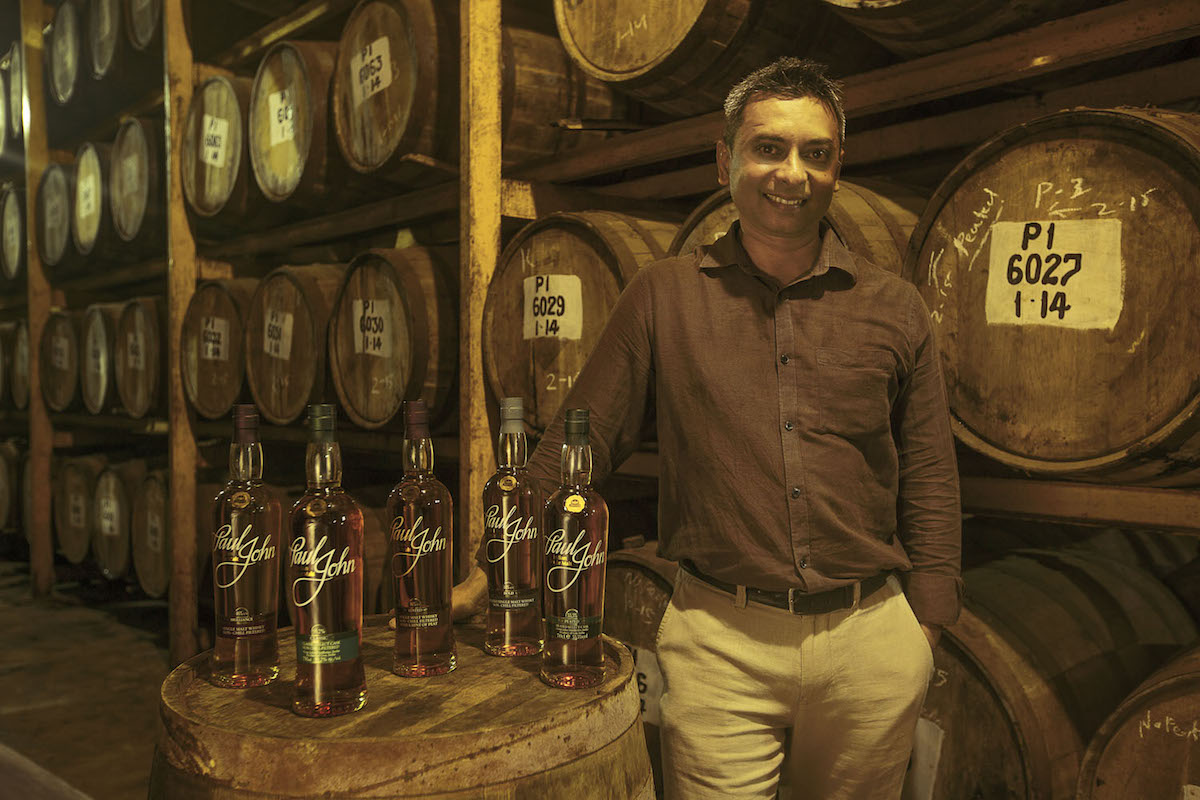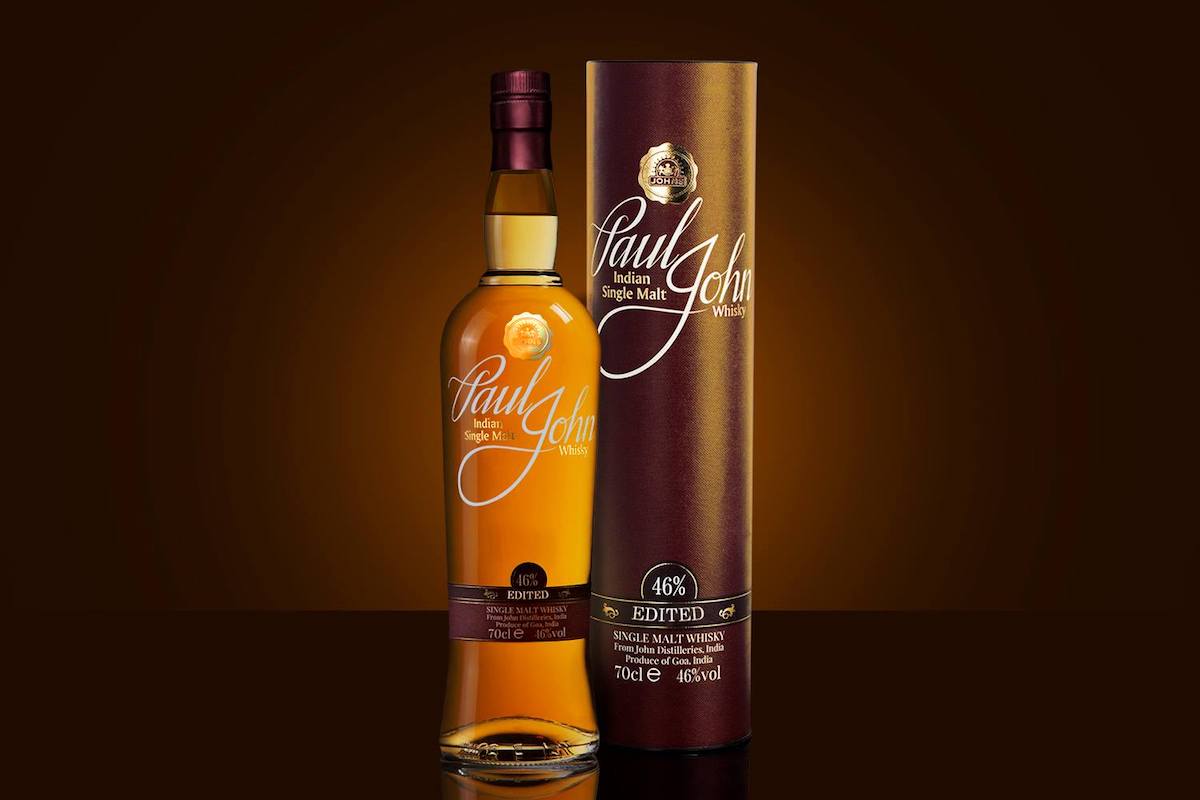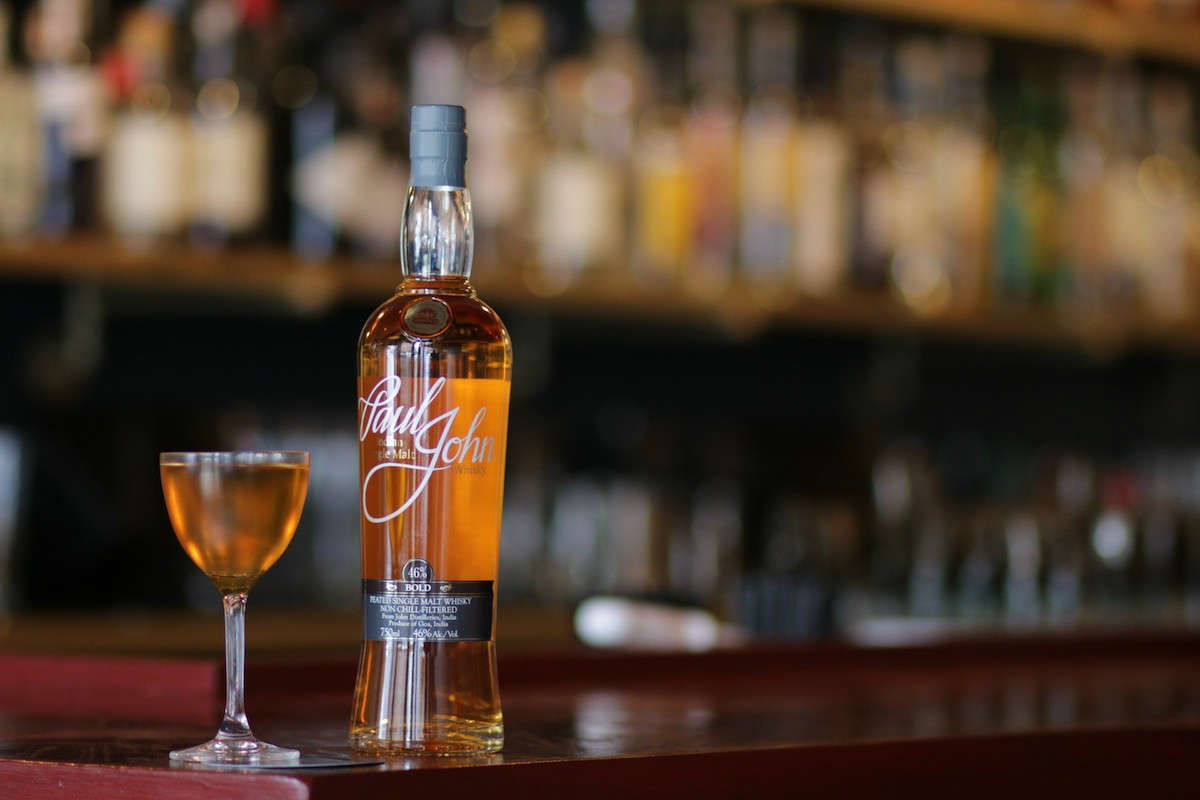Michael D’Souza is a small, soft-spoken man. You might say that his modest stature and indoor speaking voice is classic misdirection: D’Souza is the Master Distiller for John Distilleries and responsible for their line of Paul John single malts, making him a giant in the growing world of Indian whisky.
Bangalore-based John Distilleries is a large company with more than a half-dozen brands. They also produce wines and brandies, but are best known in India for their line of Original Choice whiskies. While Original Choice is sold as whisky in India—to the tune of 11 million cases per year—it wouldn’t be labeled as such outside the subcontinent. That’s because Original Choice is what’s known as an IMFL, or Indian Made Foreign Liquor, made from grains and molasses.
Things changed for John Distilleries in 2012 with the launch of their Paul John Indian Single Malt Whisky brand, a collection of five expressions that showcase what Indian water, grain and climate conditions can do for whisky. In contrast to Original Choice, Paul John is made with the international market in mind and sold mostly overseas, competing with single malt makers from Islay to Hokkaido.
He’s Got Distilling in His Genes

D’Souza’s ascension to Master Distiller occurred in 2009, but he has been with the company for over two decades. “If you ask me today what is my qualification, I will say 24 years of being in this industry,” he says. “After a period of time your experience takes over everything.”
D’Souza cites his cultural background and family history as reasons he went into distilling. As a member of a Christian family, D’Souza grew up in an environment accepting of alcohol.
“In India it can be very difficult,” he says. “We have many regions. Even today alcohol and tobacco consumption is kind of taboo.”
His interest in alcohol was further fueled by his grandfather, who was a small-time brewer.
“I guess I had the genes in me,” D’Souza says.
In 1993 D’Souza took his first job with John Distilleries, as a blender, when he was 21 years old. After five years he began distilling their IMFLs. It was a lucrative business, as domestic makers capture up to 95% of whisky sales in India, and Original Choice sells nearly one million cases per month.
But Paul P. John—the founder of John Distilleries—had always wanted to produce a single malt whisky. That dream began to feel more like a reality in 2004, when fellow Indian distiller Amrut debuted its premier single malt in Glasgow, challenging existing perceptions of Indian whisky. By 2009, Amrut Single Malt Fusion Whisky was named third-best in the world by Jim Murray’s Whisky Bible.
“Before 2000 people had a really bad perception of what Indian whisky is,” D’Souza says, “When Amrut won world’s third best whisky everything changed.”
The opportunity for John Distilleries to make a single malt had never looked better, and they travelled to Scotland to study the process. But all the studying in the world couldn’t prepare them for the real thing.
“Only when you start making it do you understand what is important,” D’Souza says. “We realized that once we came back we had to start from scratch. Nothing was similar. The grain was totally different. Everything was different. So we had to learn from doing it.”
100% Indian Whisky

Two of the biggest differences had to do with grain and climate. D’Souza sought to make a “100% Indian whisky,” and so shunned the two-row barley used to make most whiskies in favor of Indian six-row barley. This choice was more than patriotic: it affected the flavor of the whisky, too. In comparison to European two-row, Indian six-row barley contains higher levels of proteins and enzymes and less carbohydrates. According to D’Souza, this gives his whisky a richer, creamier character.
Paul John is distilled in Goa, a state in Western India with a tropical climate and a coastline along the Arabian Sea. Goa was chosen for its high quality water and more liberal liquor laws.
“It’s a tourist destination. People come to Goa from all over the world,” D’Souza says. “Goa is the one state that is very liberal.”
Goa has a humid, hot climate. According to D’Souza, the temperature in Goa never dips below 23 degrees Celsius (73.4 degrees Fahrenheit). This has a major impact on the whisky’s maturation process. D’Souza says that one year spent in Goa is equivalent to four years in Scotland. The intensity of the climate makes the angel’s share particularly brutal—D’Souza says it can be as high as eight percent per annum. The climate also imparts flavor: in D’Souza’s telling, the salt air coming off the Arabian Sea gives the whisky more mineral character.
While Goa’s benefits include favorable laws, quality water, quick maturation, and a touch of salt, it comes with a major drawback, too. Goa experiences just two seasons, summer and monsoon, skipping winter entirely. Faced with a lack of environmental diversity, D’Souza decided to make his own microclimates by building above and below-ground warehouses for the whisky, which is aged in American Oak barrels sourced from Jack Daniel’s and Buffalo Trace.
The whisky aging in the warehouses built above ground, exposed to the full might of Goa’s humidity, has a more robust character. The whisky resting in the underground warehouses, where humidity has been slowed, is described by D’Souza as being “more elegant” and “easy-drinking.”
Paul John was intended for export from its inception, but that doesn’t mean D’Souza was designing for foreign tastebuds. According to D’Souza, the flavors of Paul John are unabashedly Indian.
“Indians have a sweet palate. They like everything sweet, elegant, and floral. We try to make our whiskies easy to drink,” D’Souza says. “At the same time, we create certain flavors in order to give a touch of Indian-ness. Our whiskies are more spicy.”
Paul John at Home, Abroad, and Beyond

The first Paul John expression was launched in 2012 in England. Today the brand has five single malt expressions. There are three flagships, dubbed Brilliance, Edited, and Bold, and two select cask finishes: Peated and Classic. In addition, Paul John distributes occasional single cask releases. The latest is Kanya—which means “virgin” in Hindi—and is set for a 1,500 bottle release in early 2018. The 20 casks selected by D’Souza represent some of Paul John’s oldest stock: they have been aged in Goa for eight years, which he compares to 30 years of aging in Scotland.
Today foreign markets account for 60 percent of Paul John’s sales. The brand faces domestic sales hurdles in the form of Indian vice laws, which vary greatly throughout the country.
“India has 30 states, and each state has different rules and regulations,” says D’Souza.
Among those rules and regulations is a law banning the sale of any spirit above 42.8% ABV. Since every one of Paul John’s expressions are bottled at 46% or higher, they are not legal for sale in the majority of states.
However, D’Souza believes that the wind may be blowing in their favor. When Paul John began selling in India in 2012, only Goa and Maharashtra permitted the sale of spirits above 42.8%. In the years since, five more states have allowed higher-proof spirits to be sold, according to D’Souza.
That’s great news for the master distiller, who considers India to be a key emerging market for single malt whisky.
“The Indian economy is one of the four biggest in the world. People want to try different whiskies. People have started traveling more. People are getting more and more single malts,” he says.
D’Souza is non-plussed on the question of competing with other domestic single malts.
“If you compare Amrut and Paul John, both are different whiskies because we are from different regions altogether. We are approximately 500 miles apart. They are from down South where it is cooler and drier. We are from the Western coast where the climate is hot and humid. So although we use the same ingredients, we make two types of whisky.”
Paul John’s single biggest market outside of India is the United States, which D’Souza chalks up to its size and long history of consuming whisky. Its second largest foreign market is France. It has recently entered the Japanese market, and also sells in Taiwan, Singapore, and Malaysia.
In regards to future plans, D’Souza says: “Currently our goal is to keep on evolving whiskies. We are focusing more on quality, than on quantity.”
But this past August, Paul John succeeded in doubling its production capacity from 2,500 liters a day to 5,000—evidence that it may be succeeding on both fronts.



